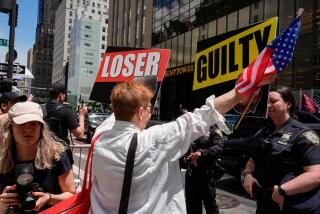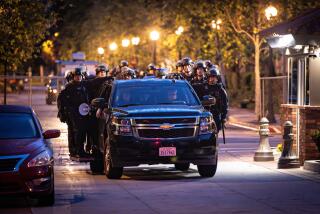The Port Huron Statement: A manifesto reconsidered
- Share via
“We are people of this generation, bred in at least modest comfort, housed now in universities, looking uncomfortably to the world we inherit.”
Those were the opening words of the Port Huron Statement, which I helped draft 50 years ago this summer as the founding document of Students for a Democratic Society. The statement, written in the idealistic early days of the New Left, laid out a vision for a nation in which racial equality would be finally achieved, disarmament embraced and true participatory democracy would become the norm.
The group that gathered in Port Huron, Mich., in 1962 to produce the statement included children who’d rejected the Old Left of their parents, black student civil rights activists seeking Northern campus allies, children of the New Deal labor-left and student journalists from Austin, Texas; Ann Arbor, Mich.; and elsewhere in the country. We gathered in small groups at a conference center near Lake Huron to discuss and revise sections of the draft that addressed racism and poverty, the Cold War and the nuclear arms race, campus apathy and the need for a new majority movement with students as the catalysts of social change.
Looking back, it feels as though the Port Huron Statement wrote us, not the other way around.
A strong spiritual sentiment ran through the group, triggered by the righteous force of the civil rights movement. Delegates moved a section on values to the front, on the grounds that our politics stemmed from our morals. But a section that was to be devoted to religion failed to make the final version because the Christian student chairing the committee fell asleep after a fourth all-nighter. (Those lost passages — I call them the “Port Huron scrolls” — will appear in a book to be published this fall by Paradigm.)
It was hardly a perfect document. It contained sexist language (it was written a year before the publication of Betty Friedan’s “The Feminine Mystique”), and there were many things it didn’t foresee, such as the assassination of President Kennedy, the 1965 escalation in Vietnam and the looming environmental threats to the planet. But when we finished, it seemed like “a holy moment,” as my then-wife, Sandra Cason, later put it. Al Haber and I even drove to the White House to deliver a copy to presidential advisor Arthur Schlesinger Jr., in case the Cold War liberals could be engaged in discussion.
The achievements that came from participatory democratic activism in the years that followed the statement’s publication were considerable: the ending of the Vietnam War and the draft, the enfranchisement of Southern blacks and young people, the rise of the feminist movement, the Roe vs. Wade decision, the growth and strengthening of public employee unions and California farmworkers, Richard Nixon’s unsurpassed environmental laws (in response to the first Earth Day), the Americans with Disabilities Act (in response to activists in wheelchairs occupying federal buildings), and much more. Former Los Angeles City Councilwoman Jackie Goldberg remembers carrying her copy of the statement to study groups during the free-speech movement, and Carl Wittman, a Port Huron-era activist who was closeted in 1962, later drew on it for inspiration in writing “A Gay Manifesto.”
During the Vietnam years, SDS abandoned the Port Huron vision as “too reformist” and turned instead to more radical ideologies of resistance and revolution.
But the Port Huron vision of a participatory democracy, of a society in which all people have the right to a voice in the decisions affecting their lives, still resonates. In the last year, those same principles have fueled movements around the world — in Cairo, in Madrid, in Zuccotti Park, to name a few. And in the Internet age, the prospects for participatory democracy are greater than ever.
I grew up in a time of alienated anti-heroes like Holden Caulfield and James Dean. But after seeing the courage of black people in the South fighting Jim Crow laws, I was converted to activism. The students I met there were inspiring, willing to die for a cause if it took that, but they didn’t want to die in vain. They had a strategic political plan for dislodging the entrenched Dixiecrat leaders of the Democratic Party from their unrepresentative power. I began drafting the Port Huron Statement from a segregated jail cell in Albany, Ga., after a freedom ride.
Recently, I saw the same spirit I had witnessed in the South 50 years ago — the spirit that inspired the Port Huron Statement — in the actions of undocumented undergraduates risking deportation to stand up for the Dream Act. I saw it in the Wisconsin movement to recall Gov. Scott Walker, and in
Occupy Wall Street’s insistence that 1% of the population shouldn’t control such a vast portion of
the country’s wealth. (In fact, that felt like a direct echo of the Port Huron Statement, which complained in 1962 that 1% of Americans owned 80% of all corporate stock, and that their percentage of all wealth had remained constant since the 1920s, in spite of the New Deal reforms.)
These new movements have grown up because courageous people saw wrong and decided to push for what was right. And if they should begin to grow cynical or discouraged by how difficult it is to make change, they might consider how things looked to us in 1962. As we put it in the final words of the Port Huron Statement:
“If we appear to seek the unattainable, as it has been said, then let it be known that we do so to avoid the unimaginable.”
Tom Hayden, a longtime activist and former member of the California Legislature, taught a UCLA class on student-led democracy movements this year.
More to Read
A cure for the common opinion
Get thought-provoking perspectives with our weekly newsletter.
You may occasionally receive promotional content from the Los Angeles Times.










